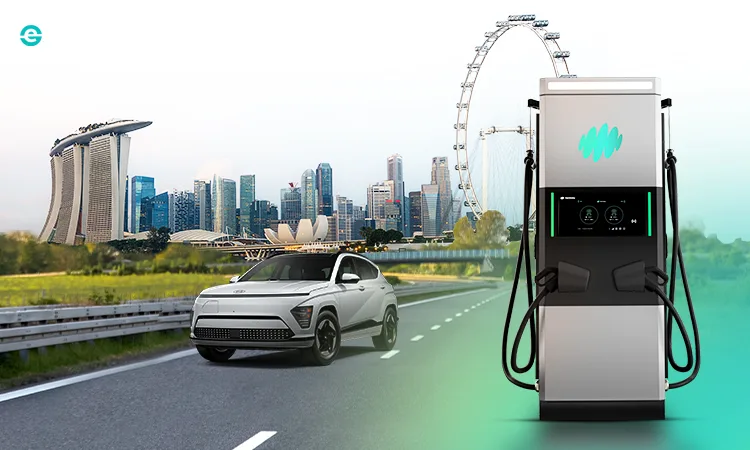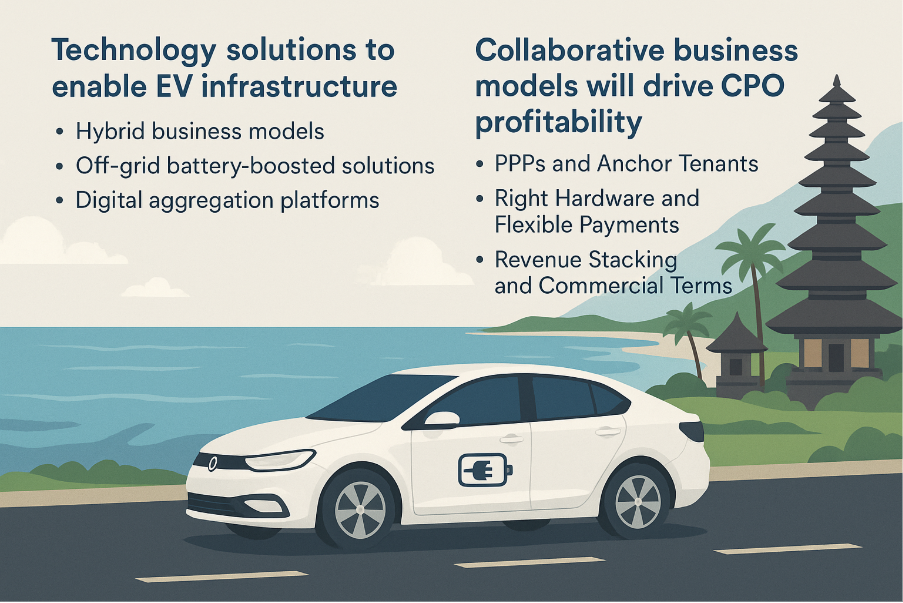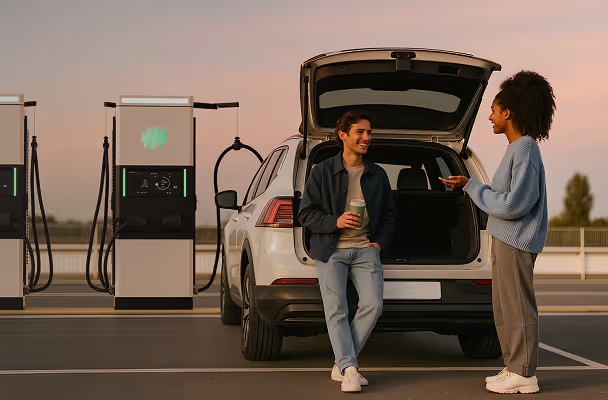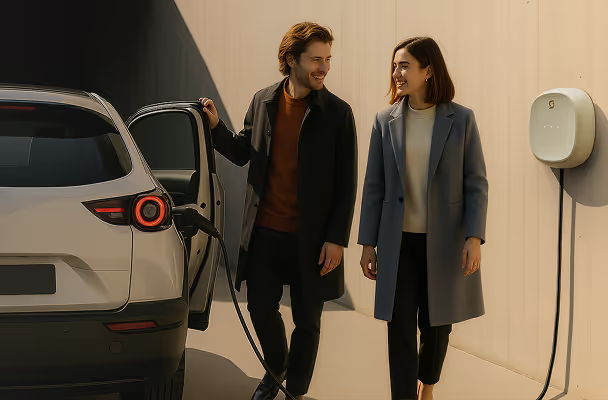Building Sustainable Southeast Asia Tourist Corridors

Southeast Asia has some of the highest growth tourism spots in the world. With over 120 million international arrivals in 2024, it has become a major economic driver for the region. Unsurprisingly, it is driving over 8% of global greenhouse gas emissions, which happens to somewhat undermine this otherwise great story. Aware of this, the government of Thailand, Indonesia, Malaysia and other countries have already taken policy steps to eliminate vehicular pollution by crafting very supportive EV policies. However, structural constraints limit EV adoption in tourism hubs – driven by seasonality, grid constraints and fragmented fleets. The time has come to build the EV infrastructure that overcome these constraints and drive faster EV adoption. With some smart implementation moves, these areas will not only see higher EV adoption, but also substantial profitability for Charge Point Operators. Lets dive in.
Tourism hubs lack EV charging infrastructure
Like elsewhere in the world, Southeast Asia is also seeing significant growth in EV usage. An EY report predicts that this will be a $80-100 billion industry by 2035. This is driven by a 9x increase in chargers since 2022 – with over 24,000 chargers installed. Indonesia alone has seen nearly 300% increase in public station in 2024.
This growth, however, is concentrated in urban centres like Bangkok, Jakarta, and Manila. When we look at eh major tourism hubs, the story is less exciting. In key corridors, especially around scenic routes, EV charging infrastructure is painfully lacking. You would be hard-pressed to find EV chargers in the Bangkok-Chiang Mai route in Thailand, the Bali Loop in Indonesia, Malaysia’s East Coast Expressway, or the South Luzon Expressway (SLEX) in the Philippines. Needless to say, if you are on a vacation in these areas, you are still resorting to using ICE vehicles.
Unfortunately, this means that tourists are disproportionately contributing to greenhouse gas emissions in Southeast Asia. The key question is, why are Charge Point Operators (CPOs) not banking on the tourism sector? The answer is – three key structural challenges.
Three Structural challenges limit EV charging infrastructure
It is difficult to economically build EV charging infrastructure in these key tourism routes, fundamentally due to seasonal utilization, poor grid and land availability and a fragmented fleet industry.
Seasonality leads to Skewed utilization expectations
Tourism is a seasonal industry driven by weather and holidays. Airbnb sees demand vary from lower than 40% in February to over 50% in August. While this is mild variability, price variability is higher at 50-60% variation in revenues per location. This leads to a wide variation in the disposable income of tourists and hence is likely to drive a significant variation in EV utilization.
Grid and Land constraints curtail charging economics
Rural and coastal highways frequently lack the robust grid infrastructure needed to support banks of DC fast chargers, as they are spaced between high population zones. Philippines regularly experiences regional brownouts and supply interruptions. Vietnam experiences localised shortages and limited high-power load connections in provincial corridors. Indonesia sees constrained charger roll-out due to fragmented islands. All these lead to lack of grid support for DC fast chargers.
Even where national programs accelerate, they upgrade in high population zones and do not drive universal coverage. Hence, coastal and provincial highways in Vietnam and northern Thailand continue to report limited feeder capacity and long lead times for grid reinforcement
Additionally, securing suitable, affordable land for charging stations in scenic areas or small provincial is generally cumbersome and expensive
Fragmented Fleet industry is unable to coordinate efforts
Just like these coastal countries have fragmented tourist spots spread across islands, so are the tourist vehicle fleet operators. This means there are no “anchor” customers for Charge point Operators (CPOs). The tourist vehicles have many small, independent operators - Jeepney cooperatives in the Philippines, Tuk-tuk drivers in Thailand, small tour bus companies and local rental car agencies. There are some example of aggregation – like Bangkok’s app-aggregator MuvMi , which has deployed > 600 electric tuk-tuks across multiple neighbourhoods.
Technology solutions can enable EV charging infrastructure

The good news is – there are solutions that are already in development in these areas and they need to be encouraged for better EV charging infrastructure penetration.
Off-grid battery-boosted solutions
Modular off-grid solutions which use compact all-in-one design, that utilize solar charging plus battery storage systems reduce implementation costs and ensure continuous supply of high-voltage electricity
The Right Hardware and Flexible Payments
Physical infrastructure choice must focus on Durability, Interoperability and Flexible payment methods. The right hardware will need to be weatherproof to tropical climates, support various charging standards, and accommodate the region’s diverse payment landscape, including QR codes (Vietnam), e-wallets (Indonesia), RFID cards (Philippines), and credit cards.
Digital aggregation platforms
Digital aggregation platforms, such as apps can coordinate thousands of small operators by enabling predictable, contractual demand and real-time routing that smooths utilisation. Beyond bundling demand and managing charging needs of fleet operators, these apps can also help drivers find the best charging station and create charging supporting route plans. The analytics layer on such tools can help identify high volume areas for EV charging setups and enable location choice for CPOs.
While these technology solutions help overcome the main challenges, they require an investment setup that is difficult for any single player. Henc the need to create collaborative business models is imperative.
Collaborative business models will drive CPO profitability
Like every other sustainability initiative, EV adoptions also need the entire ecosystem to collaborate. Fortunately, the government policies are already in place. The need, now, is to drive commercial arrangements.
Hybrid business models
Hybrid business models – that serve locals and tourists, and enable seasonal pricing models – can help solve for skewed utilization and even out economics. Such models should also choose locations that are aligned with some ‘anchor’ customers like hotels – like Mariott which advertise EV charging to its environmentally conscious international guests.
Public-Private Partnerships (PPPs) and Anchor Tenants
Partnerships that bring together CPOs, national tourism boards (like Thailand’s TAT), and major hospitality groups is most likely to succeed. This model ensures hotels and airports act as anchor tenants, providing land and a baseline of customers. These contracts should consider multi-year land-lease agreements, minimum revenue guarantees during low season, and shared capex on grid reinforcement and other infrastructure investments
Revenue Stacking and Commercial Terms
Operators must combine multiple modest revenue streams, such as:– Pay-per-kWh or pay-per-minute, Parking and convenience fees, Advertising / sponsorships and Seasonal reservations sold to tour operators or fleet aggregators.
These business model and technological solutions need to be well coordinated. The following actions can prioritise key corridors and de-risk CPO economics.
Final Thoughts
Establishing strong EV charging infrastructure in Southeast Asia is essential to facilitate the growing tourism and promote sustainable transportation. Addressing structural obstacles through intelligent technology and collaborations will enable CPOs to achieve profitability. Act now and discover Exicom’s groundbreaking EV charging solutions and drive the region’s sustainable future.
Also Read : Charger Technologies That Cut OPEX for CPOs in Southeast Asia
Frequently Asked Questions
Lorem ipsum dolor sit amet, consectetur adipiscing elit, sed do eiusmod tempor incididunt ut labore et dolore magna aliqua. Ut enim ad minim veniam, quis nostrud exercitation ullamco laboris nisi ut aliquip ex ea commodo consequat. Duis aute irure dolor in reprehenderit in voluptate velit esse.
Lorem ipsum dolor sit amet, consectetur adipiscing elit, sed do eiusmod tempor incididunt ut labore et dolore magna aliqua. Ut enim ad minim veniam, quis nostrud exercitation ullamco laboris nisi ut aliquip ex ea commodo consequat. Duis aute irure dolor in reprehenderit in voluptate velit esse.
Lorem ipsum dolor sit amet, consectetur adipiscing elit, sed do eiusmod tempor incididunt ut labore et dolore magna aliqua. Ut enim ad minim veniam, quis nostrud exercitation ullamco laboris nisi ut aliquip ex ea commodo consequat. Duis aute irure dolor in reprehenderit in voluptate velit esse.
Lorem ipsum dolor sit amet, consectetur adipiscing elit, sed do eiusmod tempor incididunt ut labore et dolore magna aliqua. Ut enim ad minim veniam, quis nostrud exercitation ullamco laboris nisi ut aliquip ex ea commodo consequat. Duis aute irure dolor in reprehenderit in voluptate velit esse.
Lorem ipsum dolor sit amet, consectetur adipiscing elit, sed do eiusmod tempor incididunt ut labore et dolore magna aliqua. Ut enim ad minim veniam, quis nostrud exercitation ullamco laboris nisi ut aliquip ex ea commodo consequat. Duis aute irure dolor in reprehenderit in voluptate velit esse.



